
Ever wondered about the secrets hidden within Egyptian monasteries? These ancient sanctuaries hold a wealth of history, culture, and spirituality. From their origins in the early days of Christianity to their role in preserving ancient manuscripts, Egyptian monasteries offer a glimpse into a world where faith and tradition intertwine. Did you know that some of these monasteries date back to the 4th century? Imagine walking through corridors that have witnessed centuries of devotion and learning. Curious about the daily lives of monks? Their routines, filled with prayer, work, and study, reflect a commitment to a life of simplicity and contemplation. Ready to uncover more? Dive into these 29 fascinating facts about Egyptian monasteries and discover the rich tapestry of history and spirituality they offer.
Key Takeaways:
- Egyptian monasteries have a rich history dating back to the 4th century, serving as centers of learning, preserving ancient texts, and inspiring art and literature.
- Monks in Egyptian monasteries follow strict schedules of prayer, engage in manual labor, and celebrate traditions and festivals, while also embracing modern technology and promoting peace through interfaith dialogues.
Ancient Origins of Egyptian Monasteries
Egyptian monasteries have a rich history dating back to the early centuries of Christianity. These sacred places have witnessed countless events and transformations over the years.
- The first Christian monastery was established in Egypt by Saint Anthony the Great in the 4th century.
- Saint Pachomius founded communal monasticism in Egypt, creating the first monastic community.
- The Monastery of Saint Macarius the Great, founded in 360 AD, remains active today.
- Egyptian monasteries were initially built in remote desert locations to escape persecution.
- The White Monastery, founded by Saint Shenouda the Archimandrite, is known for its unique architecture.
Architectural Marvels
The architecture of Egyptian monasteries is a testament to their historical and cultural significance. These structures blend simplicity with grandeur.
- Many monasteries feature high walls and towers for protection against invaders.
- The Monastery of Saint Catherine, located at the foot of Mount Sinai, is one of the oldest working Christian monasteries in the world.
- Monasteries often include churches, chapels, and cells for monks.
- The Red Monastery is famous for its vibrant frescoes and intricate carvings.
- Some monasteries have underground tunnels and secret passages for safety.
Spiritual Practices and Daily Life
Monastic life in Egypt revolves around prayer, work, and community living. The daily routines of monks are deeply rooted in spiritual practices.
- Monks follow a strict schedule of prayers, starting before dawn and continuing throughout the day.
- Silence is observed during certain hours to encourage meditation and reflection.
- Monks engage in manual labor, such as farming and crafting, to sustain the community.
- Many monasteries have libraries containing ancient manuscripts and religious texts.
- Fasting is a common practice, with monks abstaining from certain foods on specific days.
Cultural and Historical Impact
Egyptian monasteries have played a significant role in shaping religious and cultural landscapes. Their influence extends beyond spiritual realms.
- Monasteries served as centers of learning and education during the Middle Ages.
- They were instrumental in preserving ancient texts and knowledge.
- Many monasteries became pilgrimage sites, attracting visitors from around the world.
- The Coptic Orthodox Church, one of the oldest Christian denominations, has its roots in Egyptian monasticism.
- Monasteries have inspired countless works of art, literature, and music.
Modern-Day Monasticism
Despite the passage of time, Egyptian monasteries continue to thrive and adapt to contemporary challenges. They remain vital centers of faith and community.
- Many monasteries have embraced modern technology, using solar panels and other sustainable practices.
- Some monasteries offer retreats and spiritual guidance to visitors seeking solace.
- The Monastery of Saint Bishoy is known for its hospitality and welcoming atmosphere.
- Monks often engage in interfaith dialogues, promoting peace and understanding.
- Restoration projects are underway to preserve ancient structures and artifacts.
Unique Traditions and Festivals
Egyptian monasteries celebrate various traditions and festivals that reflect their rich heritage. These events are marked by joy, devotion, and community spirit.
- The Feast of Saint Anthony is celebrated with special prayers and processions.
- Monks commemorate the founding of their monasteries with annual festivals.
- Pilgrims participate in the Holy Week celebrations, which include reenactments of biblical events.
- Many monasteries host cultural events, such as music and dance performances, showcasing their vibrant traditions.
Final Glimpse at Egyptian Monasteries
Egyptian monasteries hold a treasure trove of history and culture. From their ancient origins to their role in preserving Christian heritage, these sacred places offer a unique glimpse into the past. Monks and nuns dedicated their lives to prayer, study, and community service, creating a legacy that still resonates today. The architecture, art, and manuscripts found within these walls are invaluable to historians and tourists alike. Visiting these monasteries provides a deeper understanding of Egypt's rich religious tapestry. Whether you're a history buff or just curious, exploring these sites can be a rewarding experience. So next time you're in Egypt, consider adding a monastery visit to your itinerary. You'll walk away with a newfound appreciation for the resilience and devotion that shaped these remarkable institutions.
Frequently Asked Questions
Was this page helpful?
Our commitment to delivering trustworthy and engaging content is at the heart of what we do. Each fact on our site is contributed by real users like you, bringing a wealth of diverse insights and information. To ensure the highest standards of accuracy and reliability, our dedicated editors meticulously review each submission. This process guarantees that the facts we share are not only fascinating but also credible. Trust in our commitment to quality and authenticity as you explore and learn with us.
